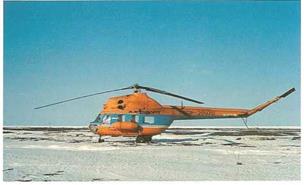Airline Helicopters
Reviving a Tradition
Back in the days of Tsarist Russia, Igor Sikorsky had made some experiments with helicopter designs, and was to revive his ambitions to pioneer vertical lift flights in America where he had emigrated at the outbreak of Revolution in St Petersburg in 1917. Not until the late 1940s did the helicopter spin its way upwards again in the Soviet Union, and not until the late 1950s was it put into commercial operation.
By this time, commercial helicopters had been innovatively introduced in the United States, to operate subsidized mail and passenger services in Los Angeles, New York, and Chicago; in Belgium, where a vigorous hub was established in Brussels for international services; and sporadically in Great Britain, for mail and passenger services. Interestingly, in the Soviet Union, though for different reasons, the program of helicopter operational development never became a prominent part of the scheduled passenger air network. But Aeroflot helicopters did carve important niches in areas where even the An-2 could not reach adequately.
|
Mikhail Mil, father of the famous series of Soviet helicopters, surveying the scene in 1959. (Boris Vdovienko) |
Routes in the Crimea
Aeroflot’s first helicopter services were in the Crimea, where mountainous terrain on the popular coastal vacation area prevented the establishment of airports with long paved runways; and even the laying down of strips for the Antonov An – 2. On 15 December 1958, a Mil Mi-4 eight-seater made the first flight from the main airport at Simferopol to Yalta, one of the delightful destinations of what may be termed the Crimean Riviera. This was followed shortly afterwards by a similar service on the Black Sea coast of the Russian Caucasus, from the main aiiport at Adler to the big resort of Sochi. Mi – 45 from Adler also connected to Gagra, Khosta, Lazarevskaya, and Gelendzhik.
City Services
In 1960, further helicopter routes were opened. On 2 March, Mi-4s began a shuttle service from the Caspian oil capital of Baku to Neftune Kamne, an artificial island offshore and site of highly productive oil wells. On 19 July a helicopter station opened at Khodinka (Frunze) airfield, where Aeroflot’s central bus terminal had been established on Leningradski prospekt, only four miles from Red Square. Mil Mi-4s carried passengers to Sheremetyevo Airport, and on 1 November a similar connection was made to Vnukovo and Bykovo Airports. Moscow’s fourth airport, Domodedovo, was added the next year.
For about a year, in 1964-65, the Mi-4 was also used for an
|
A Mil Mi-2 on Chkalov (formerly Udd) Island, in the Bay of Sakhalin. On the left can be seen the tiny pole, erected as a commemorative monument by Vadim Rotnanuk, helicopter mechanic and founder of the local air museum. This was before the erection of the permanent monument (see page 32). (R. E.G. Davies) |
|
A Mil Mi-4 (SSSR-35277) alights on the roof of the main Post Office building in the center of Moscow. The helicopter mail service lasted about two years in 1964-65, but was terminated because a certain ‘important lady’ complained about the noise. (Boris Vdovienko) |
experimental postal service, carrying mails directly from the roof of the post office in the center of Moscow to the airports. Such services had been tried as early as 1939, in Philadelphia, U. S.A., using a Kellett autogiro, but lasted only about one year. The Aeroflot services were rumored to have been terminated because the wife of a prominent political figure complained of the noise.
A Public Utility
Although helicopter services were tried in Australia, Canada, Italy, Pakistan, and Japan during the 1960s, none was sustained for very long, simply because helicopters are very expensive to operate. In the United States, where the three big city helicopter companies had been augmented by a fourth, at San Francisco, these too went into decline, partly because the Civil Aeronautics Board withdrew subsidy in 1965, and partly because of well-publicized fatal accidents. All were finished by 1979.
In the Soviet Union, on the other hand, where profit-and – loss statements were non-existent, and all air services were provided as a public utility, helicopter services continued to flourish in any region of the far-flung territory where they were needed: delivering mail in the northern tundra to outlying communities of the Arctic, or to inaccessible places in the mountains of Tadjikistan or Kirghizia, or to villages in northern Kamchatka, where even the An-2 was vulnerable. The use of helicopters is dictated by operational necessity, not economic feasibility, judged by western criteria; and they are often to be found in the regional timetables of Aeroflot, deployed interchangeably with other feeder aircraft.
|
|













